Top business and tech leaders convened at London’s National Theatre on the 16th of April for Babble’s Fit to Lead Executive Lunch and Forum. ‘The Corporate Philosopher’, Roger Steare began the second half of the event with his presentation Ethics in the Age of God-Like Technology which shed invaluable insights into becoming an ethically-fit leader.
Reading Time: 8 minutes
What This Blog Covers:
Leading with Integrity
The role of leadership has never been more critical: the rapid technological advancements of the digital era we live in come with a host of unprecedented and complex ethical challenges. In the previous blog, we introduced you to renowned leadership expert, Roger Steare, and unpacked the nuances of personal and AI ethics. Now, we will dive into the core of ethical decision-making, exploring the concept of MoralDNA and its application in the workplace. We uncover the stark contrast between rule-based compliance and values-driven leadership and share Roger’s practical strategies for fostering ethical cultures. Join us as we explore how to navigate the complexities of modern IT solutions for businesses with integrity and purpose.
MoralDNA: The Blueprint for Ethical Leadership
In a nutshell, your MoralDNA is your inner compass that helps you decide what’s right or good. It encompasses three elements: people, values and rules.
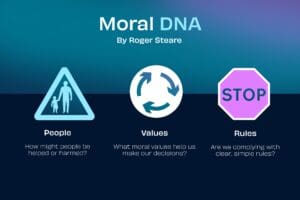
People
This gets you to ask yourself whether you are doing the right thing for others and interrogate how your decisions are affecting the people around you. Philosophically, this speaks to the ethic of care, consequentialism, and utilitarianism.
“Compassion is the basis for morality.” – Arthur Schopenhauer
Values
These are your moral values – such as fortitude, humility, compassion, fairness, and justice. According to Roger, the most important values you have are moral values. Those are the bedrock of our decision-making: they don’t tell us what to do, they hint. Incorporating these values in your decision-making will help you answer the question: ‘What would be the fair, compassionate or courageous thing to do here?’ Conversely, if your community or social group has a set of values but no core moral values, then they are not going to help you make the right decisions.
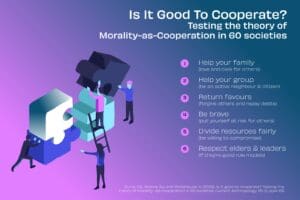
Rules
Roger used the traffic sign analogy to unpack this element of our Moral DNA. When we see the pedestrian crossing sign, for example, we essentially have to think about the impact of our actions on other people. We have to give way and make a judgement about when it’s safe to join the stream of traffic. The same applies to values: you have to use judgement in ethical decision-making.
“Rules are for the obedience of fools and the guidance of wise men [and women].” – Harry Day
When it comes to the rules, you simply have to do as you’re told. This can of course be a good or a bad thing, depending on who is setting the rules and whether they follow the right kind of logic.
Tip: click here to discover your MoralDNA type and gauge your ethical fitness.
Differences in Morality: Work vs Society
While some rules are universal and speak to common sense – such as not hurting other people and helping them instead, or not stealing and only taking your fair share – others are less obvious and differ from person to person. With that being said, our MoralDNA might change at work, as this is due to the difference between our society and the communities we join at work.
In the previous blog, we spoke about the fact that leaders aren’t elected in the workplace and how this places the responsibility to exercise ethical leadership squarely on their shoulders. While we’re all familiar with the age old saying, ‘with great power comes great responsibility’, we also know that many people abuse their power.
To illustrate this point, Roger asked the crowd to type ‘why is my boss’ into the Google search bar to see how the sentence would be auto-completed. Most to all of the results were negative – try it yourself.
It may come as no surprise that workplace bullying is at a pandemic level – which makes ethical leadership that much more fundamental. Leaders essentially determine whether the business has a positive workplace culture or a toxic work environment.
Given that leadership is a team sport, Roger conducted research that took a holistic approach to ethical leadership by looking at the rest of the organisation as well. Working with various groups like Chartered Management Institute, EY and PwC, he observed the challenges of risk, culture, behaviour and corporate integrity in financial services.
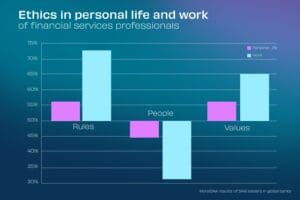
The findings uncovered what was happening when people came to work and what was dominating people’s ethical compass when making decisions. The results showed that people are dominated by compliance with rules, which means that when at work, people rely on leadership to decide what is right and forgo their own judgment.
Fear vs. Values
Unpacking this further, the difference between the high score on rules and the much lower score on people is due to what is known as the ‘fear factor’. The compliance with rules is driven by the fear of consequences of breaking the rules – or getting caught breaking the rules.
“What we’re trying to do is to get some consistency between our personal ethical fitness and our professional ethical fitness. If the microculture of our team is consistent with our values and we’re treated by the team leader with respect, how much less effort does that take than trying to second-guess what you think he or she wants you to do or needs you to do?” – Roger Steare
People who are working in fear-driven team cultures spend more mental and emotional energy protecting themselves. This severely degrades their ability to do their job because they are more focused on avoiding trauma. From this, we see that leaders of such toxic work environments oftentimes exhibit the psychological phenomenon known as ‘dark traits’.
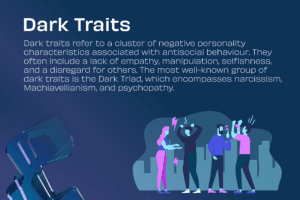
Thus, having the right values becomes extremely crucial for leaders especially when working in an enterprise that has thousands of rules. Making the right choices comes down to the values behind the good simple rules. Roger urged leaders to put the rules briefly to the side and instead ask themselves questions such as, ‘Are we being fair to customers? Are we being supportive of our people?’
From Rules to Results: Ethical Decision-Making
So, deciding what’s right is a collective effort and calls for leaders to place their people above rules and values. When presented with difficult decisions at work, meetings – when structured in a certain way – are the best way to tackle them.
“A meeting has to have a purpose. A meeting needs at least one question that needs answering.” – Roger Steare
Make meetings matter and navigate ethical dilemmas by:
- Looking to answer at least one question – and making sure it’s the right question.
- Discovering all the data and information you need to help you understand some of the answers to that question.
- Having a debate about what this data means and using your MoralDNA to come up with the right decision. This entails thinking about the outcome for other people and what values are important.
- Ensuring that your decision complies with the company rules and the law.
It’s no secret that humans are extremely social creatures: we tend to take our cues from the people around us, which is why ethical fitness in leadership is so important. The right decision is oftentimes the hardest to make. So sometimes you have to go through why something is the right thing to do – which is exactly what Roger’s coaching exercise helps you to do:
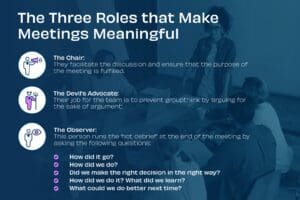
Tip: rotate the role of the chair and give everyone on the team a chance to lead the meeting. This role shouldn’t necessarily be the person with the biggest job title.
Building Ethical Businesses from the Inside Out
By prioritising people, values, and thoughtful decision-making, leaders can cultivate a culture where trust, respect, and integrity thrive. Embracing the MoralDNA framework empowers business leaders and employees alike to navigate the complexities of the modern world with confidence and purpose. Remember, ethical leadership is not a destination, but an ongoing journey that requires constant attention, reflection, and growth.
